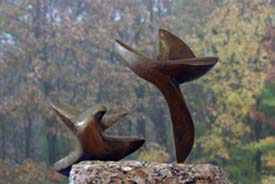
 |
|
|
 Mother Praxedes Baxter is known for her extensive work in the media of stained glass, carved marble, cast bronze and welded steel.
Mother Praxedes Baxter is known for her extensive work in the media of stained glass, carved marble, cast bronze and welded steel.  She describes the awakening of her vocation to become an artist when at the age of three, she “discovered the miracle of drawing with a pencil.” It was within the monastic setting that Mother Praxedes’ artistic gift flourished as she gradually became a monastic artist, whose role in the ancient tradition is to “transform the desert into paradise.” Rather than creating art for a museum, she is called upon to create beauty within the settings of every life, drawing those who inhabit such spaces toward the transcendent, “...so that in all things God may be glorified.” Mother Praxedes collaborated on the design of the Abbey Church of Jesu Fili Mariae and its interior appointments. Her metal sculptures, which grace the Abbey land, vividly express the potential for elevation of everyday materials to a sacramental form. Using recycled scrap metal and pieces of a rusty water tank, she created an imposing 10-foot statue of St. Anthony of the Desert who, holding a piglet in his arms, stands at the entrance to the Abbey’s pig barn. She describes the awakening of her vocation to become an artist when at the age of three, she “discovered the miracle of drawing with a pencil.” It was within the monastic setting that Mother Praxedes’ artistic gift flourished as she gradually became a monastic artist, whose role in the ancient tradition is to “transform the desert into paradise.” Rather than creating art for a museum, she is called upon to create beauty within the settings of every life, drawing those who inhabit such spaces toward the transcendent, “...so that in all things God may be glorified.” Mother Praxedes collaborated on the design of the Abbey Church of Jesu Fili Mariae and its interior appointments. Her metal sculptures, which grace the Abbey land, vividly express the potential for elevation of everyday materials to a sacramental form. Using recycled scrap metal and pieces of a rusty water tank, she created an imposing 10-foot statue of St. Anthony of the Desert who, holding a piglet in his arms, stands at the entrance to the Abbey’s pig barn.  Mother Praxedes furthered her studies by working for two years under the direction of the DeTomassi master carvers in Rome. The marble fountain she carved under their tutelage graces the greenhouse entrance of the Abbey. She was privileged to have as her mentor the esteemed bronze sculptor Giacomo Manzù, creator of the Doors of Death at the entrance to St. Peter’s Basilica, in Vatican City. Manzù generously collaborated with Mother Praxedes on the tabernacle design for the Abbey Church, two bronze doves representing St. Scholastica and St. Benedict. Mother Praxedes furthered her studies by working for two years under the direction of the DeTomassi master carvers in Rome. The marble fountain she carved under their tutelage graces the greenhouse entrance of the Abbey. She was privileged to have as her mentor the esteemed bronze sculptor Giacomo Manzù, creator of the Doors of Death at the entrance to St. Peter’s Basilica, in Vatican City. Manzù generously collaborated with Mother Praxedes on the tabernacle design for the Abbey Church, two bronze doves representing St. Scholastica and St. Benedict. A procession of life-size welded steel sheep leads visitors into the Abbey Church. Inspired by the liturgy of HOLY WEEK the sheep represent the movement of the Lamb of God through his Passion, Death and Resurrection. Each day of Holy Week a particular mystery is highlighted in the Scripture Reading or the Collects of the Mass and the Divine Office. • The Saturday before Palm Sunday, known as Commitment Saturday presents Jesus saying to His disciples, “I must go to Jerusalem,” publicly stating His unflinching commitment to His redemptive mission.  • Palm Sunday brings us into the mystery of Procession as we witness Christ’s triumphal entrance into Jerusalem. • Palm Sunday brings us into the mystery of Procession as we witness Christ’s triumphal entrance into Jerusalem. • The Gospel for Monday of Holy Week presents Mary Magdalene who bathes the feet of Jesus with her tears and dries them with her hair, embodying the mystery of Intimate Extravagance. • The collect of Tuesday accents Per Agere or Compulsion to Complete the Mission as Christ proceeds in His inexorable movement toward the Father. • Aloneness is the mystery of Wednesday; Christ stands alone in the face of His Passion. • Holy Thursday celebrates Body Given when Christ gives His Body and Blood to the disciples through the bread and wine of the Last Supper. • The theme of Good Friday Non est Lex is taken from the Lamentations of the prophet Jeremiah: the suffering, crucifixion and death of Jesus in His innocence fall outside the boundaries of rational law. • We are immersed in the mystery of Night on Holy Saturday as Christ lies dead in the darkness of the tomb. • Joyfully we enter the mystery of Miracles on Easter Sunday. "He has risen from the dead. Alleluia!" GALLERIES OF MOTHER PRAXEDES' WORK Sculpture
Works in Other Media: Stained Glass, Marble, and Bronze
|
||||||||||||||||||
| Copyright © 2013 Abbey of Regina Laudis. All rights reserved. | |||||||||||||||||||